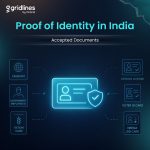When we consider banking, we commonly visualize savings accounts, loans, debit cards, and phone apps that allow us to transfer money instantly with a tap of our screen. Yet, beneath this seamless process is a working web of compliance and verification procedures meant to secure customers and banks. One of the less familiar but equally important terms in this arena is the Officially Valid Document (OVD).
While the name may sound formal, knowing what an OVD is and why it is important is crucial for anyone dealing with Indian banks today. In fact, OVDs are central to a customer’s relationship with the bank, particularly when it comes to opening accounts, processing loans, and identity verification under anti-money laundering regulations.
In this blog, we shall dissect what an OVD is, the regulatory structure associated with it, where it is mandated in banking, and why it has turned into a pillar of trust in India’s financial world.
What Does OVD Mean in Banking?
OVD is an acronym for Officially Valid Document.
In other words, these are documents acknowledged officially by the Government of India and regulators like Reserve Bank of India (RBI) as valid documents of a person’s address and identity.
The concept of OVD emerged primarily from the Prevention of Money Laundering Act (PMLA), 2002, and its subsequent rules, along with RBI’s Know Your Customer (KYC) guidelines. Banks are legally required to verify the identity and address of customers before offering them services. To standardize this process, regulators listed certain documents that carry universal authenticity and are difficult to forge—these became known as OVDs.
Which Documents Are Considered OVDs?
According to the RBI Master Direction on KYC (revised from time to time), the following are considered OVDs:
Passport
- Acting as identity as well as address proof.
- Regarded very credible due to rigorous issuance procedures.
Driving Licence
- Allowed to be considered as proof of identity and present address (unless otherwise noted).
- Voter’s Identity Card (issued by the Election Commission of India)
- Known universally but questioned at times regarding address continuity.
- NREGA Job Card (signed properly by a State Government official)
- Letter sent by the National Population Register (NPR) with name and address
Key Point: PAN (Permanent Account Number) is a mandatory document when paying tax but not considered an OVD for address/identity proof under KYC regulations. It has to be produced in combination with an OVD.
Why are OVDs necessary in Banking?
OVDs are not mere paperwork for banks. They play several important functions:
- Compliance with Law
Banks are under Indian law obligated to authenticate customers prior to onboarding. The most prominent legal guidelines are:
- Prevention of Money Laundering Act (PMLA), 2002 – PMLA, Ministry of Finance
- RBI Master Direction on KYC (as updated 2023) – RBI KYC Master Direction
These regulations compel banks to accept only OVDs to achieve consistency and minimize the possibility of money laundering or terror funding.
- Fraud Prevention
Unverifiable or fake documents are one of the principal sources of banking fraud. OVDs, by their very definition, are hard to duplicate.
- Trust and Transparency
When a customer produces an OVD, the bank can trust that the relationship is genuine. This is crucial in establishing trust in financial services.
- Financial Inclusion
Low-income people, rural laborers, and migrant workers use documents such as voter IDs or NREGA job cards as their passport to organized banking.
Where Are OVDs Required in Banking?
OVD in banking are required at various points during a customer’s banking cycle. Let’s take a step-by-step approach.

1. Bank Account Opening
This is the most frequent one. Whether it is a savings account, current account, or salary account, banks need OVDs to verify your address and identity. Without an OVD, account opening cannot be continued.
2. Loan Applications
From credit cards and personal loans to mortgage loans, banks need to ensure that the applicant is authentic. OVDs need to authenticate both identity and residential address so that the bank can track the borrower if necessary.
3. Periodic KYC Updates
RBI asks banks to update customer records periodically, particularly for “high-risk” accounts. Customers might be requested again for OVDs to update their KYC.
4. High-Value Transactions
For high-value deposits, withdrawals, or remittances, banks may seek re-verification with OVDs, particularly if the customer profile seems suspicious.
5. Digital Onboarding
In digital-led models such as payment banks and fintechs, too, OVDs find use. Customers upload scanned copies of OVDs, which are authenticated against reliable databases prior to account activation.
6. Foreign Exchange and Cross-Border Transactions
For forex cards, remittances, or outward remittances, OVDs (in the case of passports) are required to comply with FEMA and AML regulations.
7. Anti-Money Laundering and Terror Funding
This is the final purpose OVDs serve. Each OVD check contributes to a clear trail, making it more difficult for criminals to exploit the banking system.
Development of OVDs in India
The category of OVDs has developed over the years. Banks used to accept a vast array of documents earlier, causing inconsistencies. After 2002, with the enactment of PMLA, the government made things more streamlined with respect to acceptable documents.
This change indicates a larger movement: away from physical paper-based authentication and toward digital, real-time authentication through APIs and centralized directories.
OVDs vs Other Documents: Dispelling the Mystery
One of the most frequent queries received by customers is: “Why is my PAN card insufficient?”
The solution lies in regulatory categorization. PAN is intended for tax compliance, not as an address/identity proof. Likewise, utility bills, rent agreement, and employer letters can confirm KYC but are not OVDs unless specifically supported by RBI instructions.
Ponder this: All OVDs are valid proofs, but all proofs are not OVDs.
Obstacles in Utilizing OVDs
As essential as they are, OVD-based verification has its own set of obstacles:
Data Accuracy Issues
Addresses do vary between documents, leading to mismatches.
Exclusion Risk
Homeless people, migrant workers, or persons without voter IDs or passports might find it hard to present OVDs, becoming at risk of financial exclusion.
Fraudulent Use
Even OVDs might be forged, albeit with increased effort. False voter IDs or duplicate driving licences have been seen.
Operational Delays
For banks, manual checks of physical OVDs delay onboarding.
Technology as a Game Changer
To address these issues, banks are turning towards digitized, API-based verification of OVDs. Some of the innovations are:
- CKYC (Central KYC Registry): Single KYC record that can be reused by all banks and financial institutions.
- Digital Document Verification APIs: Banks are able to verify driving licences, passports, and voter IDs instantly against government databases.
This transition not only lowers fraud but also enhances customer experience, allowing for faster account opening and loan sanctioning.
Why OVDs Matter More Than Ever
In the digital banking age, financial crime and cybercrime are increasing. OVDs function as the first line of defense by linking each account to a confirmed identity. For banks, OVDs are more than a compliance box—they are the cornerstone of a secure, open, and trusted financial environment.
As India strides towards going cashless, the role of OVDs will only intensify. Instant verification devices, CKYC, and digital identity systems will make OVDs even more integral to how banks function.
Conclusion
An OVD in banking is not just an identity card—it is the key to the financial system. Presenting an OVD, customers demonstrate not only who they are, but that they have a right to be part of India’s formal economy. Whether opening a straightforward savings account or obtaining a loan or executing cross-border transactions, OVDs make banking safe, compliant, and reliable.
As technology keeps advancing, banks are coming up with smarter means of authenticating OVDs in real time, striking the double balance of speed and security. For clients, grasping the worth of an OVD translates to less obstacle and a smoother ride through the world of finance.





Leave a Reply